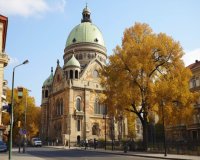Language and Culture: Yiddish Influence in Budapest

Language and Culture: Yiddish Influence in Budapest
Budapest, the capital of Hungary, is a city rich in history and culture. It's a place where various languages and traditions have left their mark over the centuries. One such influence that often goes unnoticed is the Yiddish language and culture, which has played a significant role in shaping Budapest's identity.
The Yiddish Language:
Yiddish is a High German-derived language historically spoken by Ashkenazi Jews. In the late 19th and early 20th centuries, Budapest had a thriving Jewish population, and Yiddish was a common language spoken in Jewish households and communities. It served as a means of communication and cultural expression for the Jewish residents of the city.
Yiddish in Everyday Life:
The influence of Yiddish in Budapest can be observed in various aspects of daily life. Yiddish words and phrases have found their way into the Hungarian vocabulary, creating a unique linguistic blend. While many of these borrowings have become an integral part of Hungarian slang, some Yiddish words are still used in their original form.
| Yiddish Word |
Meaning |
Usage in Budapest |
| Mazel Tov |
Good luck |
Commonly used to congratulate someone |
| Mensch |
A person of integrity |
Used to describe an upstanding individual |
| Oy Vey |
Expression of dismay or frustration |
Used in moments of exasperation |
Cultural Impact:
Beyond language, Yiddish culture has also made a lasting impact on Budapest. The city was home to a vibrant Jewish community, which contributed to the city's artistic, culinary, and intellectual life. Jewish theaters, cafes, and restaurants were an integral part of Budapest's cultural landscape.
The famous Dohány Street Synagogue, also known as the Great Synagogue, is a testament to the architectural influence of Jewish culture in Budapest. It is one of the largest synagogues in Europe and a significant tourist attraction in the city.
Preservation Efforts:
While the Yiddish-speaking population in Budapest has dwindled over the years due to historical events, efforts are being made to preserve and celebrate this rich cultural heritage. Cultural centers, museums, and educational institutions are working to ensure that Yiddish language and traditions continue to be part of Budapest's diverse cultural tapestry.
Conclusion:
Budapest's history is a mosaic of influences from various cultures and languages, and the Yiddish influence is a crucial part of this mosaic. As visitors explore the city, they may not always be aware of the Yiddish words and cultural traces that surround them, but they are a testament to the enduring impact of a vibrant and diverse Jewish community on the city of Budapest.
In summary, the Yiddish language and culture have left an indelible mark on Budapest, enriching its linguistic diversity and contributing to its unique cultural identity.
Budapest: The Great Synagogue Skip the Line Ticket
Discover the rich history of Budapest's Great Synagogue with a skip-the-line ticket. Explore the largest synagogue in Europe and second-largest in the world, delving into the fate of Hungarian Jews before and after WWII. Your guided tour covers key sites such as the Heroes’ Temple, Raoul Wallenberg Memorial Park, and the graveyard.
Skip the lines and proceed directly to the security check to embark on your journey through the Great Synagogue. Visit the Jewish Museum to gain insights into the daily life of Hungarian Jews through a collection of everyday objects. Honor Holocaust victims at the Emmanuel Tree in the Raoul Wallenberg Memorial Park, a poignant tribute with small metal leaves engraved with names of victims.
With your ticket, access the Hungarian Jewish Museum adjacent to the Synagogue, featuring a facade combining Romantic style with Moorish elements. Witness the beauty of the Emmanuel Memorial Tree in the Synagogue's backyard, adorned with metal leaves honoring Holocaust victims and non-Jewish rescuers. Conclude your visit at the graveyard, the resting place of those who perished in the ghetto during WWII.
Includes:
- Guided tour of the Synagogue, Heroes’ Temple, Raoul Wallenberg Memorial Park, and the graveyard
- Entry to Synagogue, Hungarian Jewish Museum, and temporary exhibitions in the Cellar
- Entry to Heroes’ Temple, Raoul Wallenberg Memorial Park, Lapidarium, and Synagogue’s graveyard
Ensure you comply with temple etiquette, including appropriate attire and head coverings for men. Experience a profound journey through history with this ticket to Budapest's Great Synagogue.
Meeting Point: Present your voucher at the security check at Dohány Street Synagogue.
Important Information:
- No smoking, drinking, or eating in the area
- Synagogue closed on Saturdays and Jewish holidays
- Security check upon entry; no entry with large backpacks
- Face masks recommended but not mandatory
Price: From US$ 24.98 per person
The History of Yiddish in Budapest
Budapest, the capital city of Hungary, has a rich and diverse cultural history, and this includes the presence and evolution of the Yiddish language within its borders. Yiddish, a Germanic language with Hebrew and Slavic influences, has deep roots in the Jewish communities of Budapest, contributing to the city's linguistic tapestry. In this article, we will explore the history of Yiddish in Budapest, from its origins to its role in contemporary society.
Origins of Yiddish in Budapest
The history of Yiddish in Budapest can be traced back to the late 18th century when Jewish communities began to establish themselves in the city. These Jewish immigrants brought with them the Yiddish language, which had already developed into a distinct Jewish vernacular in Eastern Europe. Yiddish served as a means of communication among Jewish residents who came from various regions and spoke different native languages.
As the Jewish population in Budapest grew, so did the influence and use of Yiddish. It became a unifying language for the Jewish community, fostering cultural exchange and religious traditions among its speakers.
Yiddish Culture and Education
Throughout the 19th century, Yiddish culture flourished in Budapest. The city saw the emergence of Yiddish theaters, newspapers, and literary works. Prominent Yiddish writers and poets like Moses Rosenfeld and Ferenc Molnár contributed to the rich literary tradition of Yiddish in Budapest, creating works that resonated with both Jewish and non-Jewish audiences.
Yiddish schools also played a vital role in preserving and promoting the language. These educational institutions taught not only Yiddish language and literature but also Jewish history, culture, and traditions. Yiddish became an integral part of Jewish identity in Budapest.
The Impact of World War II
World War II had a devastating impact on Budapest's Jewish community and the Yiddish language. The Holocaust resulted in the loss of a significant portion of the city's Jewish population, including many Yiddish speakers. The once-thriving Yiddish cultural scene was profoundly affected, and Yiddish institutions and publications dwindled.
After the war, survivors and their descendants faced the challenge of rebuilding their lives and preserving their cultural heritage, including the Yiddish language. Efforts were made to revive Yiddish culture in Budapest, but it could never fully recover to its pre-war glory.
Yiddish Today
Despite the challenges and historical setbacks, Yiddish still has a presence in Budapest today. While the number of fluent Yiddish speakers has decreased, there is a growing interest in Yiddish language and culture among younger generations. Organizations and cultural centers in Budapest offer Yiddish language courses, cultural events, and exhibitions, aiming to keep the language alive and accessible.
Furthermore, Yiddish words and expressions have permeated Hungarian slang and everyday speech, serving as a testament to the enduring influence of the language. The resilience of Yiddish in Budapest reflects the determination of the Jewish community to preserve their linguistic and cultural heritage.
Conclusion
The history of Yiddish in Budapest is a story of resilience, cultural richness, and the enduring spirit of a community that has faced significant challenges. While the language has evolved and transformed over the centuries, its legacy lives on in the hearts of those who cherish it and the broader cultural fabric of Budapest.
In a city known for its diverse cultural tapestry, Yiddish remains an integral thread, weaving together the history and heritage of Budapest's Jewish community.
Budapest: Downtown Budapest Smartphone Audio Guide
Discover the heart of Budapest and its iconic landmarks through an immersive audio guide experience. Utilize your smartphone to delve into Hungarian art, history, and gastronomy while exploring key sites like the Chain Bridge.
About this activity
Embark on a 1.5-hour audio-guided tour that takes you from the banks of the Danube, unveiling the Marguerite Bridge, Chain Bridge, and the city's origins. Encounter poignant relics from World War II and marvel at the Budapest Parliament, a 19th-century architectural masterpiece.
Delve into the history and anecdotes of Budapest, visiting significant locations like Kolodko statue, the monument of Soviet soldiers, and Freedom Square. Learn about Hungarian gastronomy and pass by institutions such as the House of Strudel and Gerbeaud.
Customize your itinerary, taking breaks at terraces or shops, and resume the tour at your own pace. The guide provides clear audio directions, and a map ensures you never lose your way. Enjoy a leisurely walk along the Danube, concluding your stroll at the main covered market of the capital.
Meeting point
To begin your audio-guided tour, visit rewindstories.com/en/activation/, enter your reservation number and email address, and unlock the tour. Download the Rewind application, create an account, and start the tour at the Danube Bank's shoes by clicking play in the Rewind application.
Important information
- An internet connection is required throughout the tour.
- Use the Rewind app on your smartphone for the tour.
- For an optimal experience, bring headphones; otherwise, sound comes from the smartphone's speakers.
- The tour begins at the specified starting point and doesn't commence elsewhere.
- Pause and resume the tour at your convenience.
- Available in English, French, and Hungarian.
- The tour duration is approximately 90 minutes.
Immerse yourself in Budapest's rich culture and history with this engaging audio-guided tour!
Exploring Yiddish Culinary Delights in Budapest
Budapest, the capital city of Hungary, is a vibrant and diverse hub of culture and cuisine. Among the various culinary influences present in the city, Yiddish cuisine holds a special place, reflecting the rich history and traditions of the Jewish community in Hungary.
Yiddish culinary delights have become an integral part of Budapest's gastronomic landscape. The Jewish quarter in Budapest, known for its historic Jewish heritage, is a treasure trove of traditional Yiddish dishes that have been passed down through generations.
The Influence of Yiddish Cuisine
Yiddish cuisine is a unique blend of flavors and traditions that have been preserved and adapted over centuries. It often features hearty, comforting dishes made with simple ingredients. Commonly used ingredients include potatoes, onions, beef, chicken, and various spices.
Popular Yiddish Dishes
In Budapest, visitors can indulge in a variety of Yiddish dishes. Some popular options include:
| Dish |
Description |
| Matzo Ball Soup |
A classic soup made with matzo meal, chicken, and vegetables, known for its comforting and savory flavors. |
| Cholent |
A slow-cooked stew typically made with beef, potatoes, beans, and barley, often enjoyed on Shabbat. |
| Kugel |
A baked pudding or casserole made from egg noodles or potatoes, often flavored with cinnamon and raisins. |
| Latkes |
Fried potato pancakes, a crispy and delightful treat often enjoyed during Hanukkah. |
Exploring Yiddish Eateries in Budapest
Budapest is home to several restaurants and eateries that specialize in Yiddish cuisine. These establishments provide an authentic taste of traditional Jewish dishes, allowing locals and tourists to experience the culinary heritage.
Celebrating the Heritage
The presence of Yiddish culinary delights in Budapest is a testament to the cultural diversity and inclusivity of the city. It's an opportunity for both locals and visitors to celebrate and appreciate the Jewish heritage, savoring the unique flavors and traditions that come with it.
In conclusion, exploring Yiddish culinary delights in Budapest is not only a gastronomic adventure but also a journey through history and culture. The fusion of traditional flavors and modern influences makes this experience a must for food enthusiasts and those eager to learn about the rich heritage of Hungarian Jewry.






